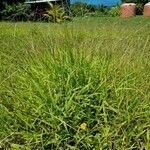Perennial with long stolons. Culms in small tufts along the stolons, compressed, nearly solid, 30–60 cm tall. Leaf sheaths keeled, glabrous or pilose along upper margins and mouth, a line of hairs abaxially at junction with blade; leaf blades lanceolate-linear, thin, 5–20 × 0.5–1 cm, glabrous or papillose-pilose along margins, apex acute. Inflorescence digitate; racemes 2, divaricate, very slender, 6–12 cm; spikelets single, in 2 rows; rachis 0.5–1 mm wide. Spikelets pale yellowish, ovate to suborbicular, 1.5–1.8 mm, abruptly acute; upper glume hyaline, 2-veined with the veins marginal, ciliate along margins with long silky hairs; lower lemma similar but not ciliate; upper lemma pallid at maturity, ovate, as long as spikelet, crustaceous, obscurely striate. Fl. and fr. May–Sep. 2n = 40, 80.
Stoloniferous perennial; culms as much as 2 m. long, but usually less than 1 m., often decumbent at the base and rooting at the lower nodes, simple or sparingly branched; stolons long, leafy, with erect or ascending flowering branches, the nodes usually conspicuously pilose; culm sheaths loose, compressed, pubescent on the collar, the margins ciliate, those of the stolons short and broad; blades mostly 8-12 cm. long, 5-15 mm. wide, thin, glabrous or sometimes pubescent, the margins scabrous or short-ciliate; racemes 2, conjugate, widely spreading, 4-15 cm. long; spikelets 1.4-2.2 mm. long, ovate, minutely pointed, the margins of the glume papillose-ciliate with long fine hairs.
Perennial, growing in small tufts which arise from vigorous stolons; culms 30–60 cm. high.. Leaf-blades broadly linear to narrowly lanceolate, 4–20 cm. long, 5–13 mm. wide.. Inflorescence composed of 2 conjugate racemes, each 5–17 cm. long, the spikelets borne singly in 2 rows on a narrow rhachis (± 0.5 mm. wide).. Spikelets orbicular, 1.5–1.7 mm. long, pale yellow; upper glume as long as the spikelet, ciliate on the margins; lower lemma similar, but glabrous; upper lemma finely striate, pallid at maturity.
A grass which keeps growing from year to year. It grows in tufts and has underground stems or rhizomes and runners or stolons. It grows 60 cm high. The flowers are green and purple.
Racemes paired, each 5–17 cm. long, the spikelets borne singly in 2 rows on a narrow rhachis.
Spikelets 1.5–1.7 mm. long, orbicular, pale yellow.
Stoloniferous perennial, often forming swards.
Superior glume ciliate on the margins.
Culms 30–60 cm. high.


